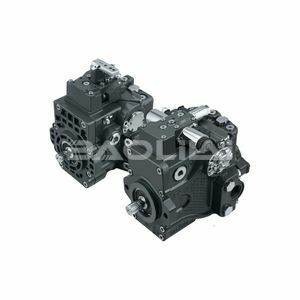Analysis of multiple factors on the relationship between high-pressure pump plunger diameter and flow rate
The relationship between plunger diameter and flow rate in high-pressure pumps is affected by a variety of factors, including pump design, operating conditions, and fluid characteristics. Generally speaking, the flow rate (Q) through the pump is determined by the displacement per revolution (DPR) and rotational speed (N) of the pump.
For reciprocating pumps, such as plunger pumps, the displacement per revolution is affected by the plunger diameter (D) and stroke length (L). Assuming other factors such as stroke length and rotational speed remain constant, increasing plunger diameter (D) will result in a proportional increase in flow. However, it is worth noting that changing plunger diameter may also affect other aspects of pump performance, such as pressure capability and efficiency.
It is crucial to consider the specific pump design, as different types of high-pressure pumps may have different characteristics and factors that affect their performance. Additionally, the relationship between plunger diameter and flow rate may be affected by practical considerations such as pump efficiency, mechanical limitations, and characteristics of the pumped fluid.
In addition to the basic relationship between plunger diameter and flow rate, it is also important to consider the impact of changing plunger diameter on other performance parameters of the pump. Here are some other factors to keep in mind:
1. Pressure Capacity: Increasing the plunger diameter can lead to higher pressure capabilities because pressure is directly related to force (affected by plunger diameter). However, it is critical to ensure that pump components, including seals and valves, can withstand the increased forces associated with larger plungers.
2. Power requirements: A larger plunger may require more power to move, which may affect the choice of pump motor or drive system. Power requirements must be considered and ensure the pump has enough power to meet the required flow and pressure.
H1-P-060-R-A-A-A5-C1-N-F5-H-F1-H6-L-35-L-35-C-P-24-PN-NNN-NNN H1P060RAAA5C1NF5HF1H6L35L35CP24PNNNNNNN
H1-P-060-R-A-A-A5-C1-N-F4-H-G1-H6-L-15-L-15-C-M-24-PN-NNN-NNN H1P060RAAA5C1NF4HG1H6L15L15CM24PNNNNNNN
H1-P-060-R-A-A-A5-C1-N-D8-H-G1-H2-L-35-L-35-C-P-24-PN-NNN-NNN H1P060RAAA5C1ND8HG1H2L35L35CP24PNNNNNNN
H1-P-060-R-A-A-A5-C1-N-D6-H-G1-NN-L-15-L-15-C-L-24-PN-NNN-NNN H1P060RAAA5C1ND6HG1NNL15L15CL24PNNNNNNN
H1-P-060-R-A-A-A5-C1-N-D6-H-G1-H3-L-30-L-42-C-L-30-PN-NNN-NNN H1P060RAAA5C1ND6HG1H3L30L42CL30PNNNNNNN
H1-P-060-R-A-A-A5-C1-N-D6-H-G1-H3-K-42-K-30-C-L-30-PN-NNN-NNN H1P060RAAA5C1ND6HG1H3K42K30CL30PNNNNNNN
H1-P-060-R-A-A-A5-C1-N-D6-H-F1-NN-L-38-L-38-C-L-24-PN-NNN-NNN H1P060RAAA5C1ND6HF1NNL38L38CL24PNNNNNNN
H1-P-060-R-A-A-A5-C1-N-D3-H-F1-H2-L-38-L-38-F-M-24-PN-NNN-NNN H1P060RAAA5C1ND3HF1H2L38L38FM24PNNNNNNN
H1-P-060-R-A-A-A5-C1-B-F6-H-G1-H6-L-23-L-23-C-L-26-PN-NNN-NNN H1P060RAAA5C1BF6HG1H6L23L23CL26PNNNNNNN
H1-P-060-R-A-A-A5-C1-B-F5-H-G1-H6-L-30-L-30-C-P-24-PN-NNN-NNN H1P060RAAA5C1BF5HG1H6L30L30CP24PNNNNNNN
H1-P-060-R-A-A-A5-C1-B-D8-H-G1-H3-L-35-L-35-F-P-24-PN-NNN-NNN H1P060RAAA5C1BD8HG1H3L35L35FP24PNNNNNNN
H1-P-060-R-A-A-A5-C1-B-D6-H-G1-H3-L-30-L-30-C-L-30-PN-NNN-NNN H1P060RAAA5C1BD6HG1H3L30L30CL30PNNNNNNN
H1-P-060-R-A-A-A5-C1-B-D6-H-G1-H3-L-23-L-23-C-L-26-PN-NNN-NNN H1P060RAAA5C1BD6HG1H3L23L23CL26PNNNNNNN
H1-P-060-R-A-A-A5-C1-B-D3-H-F1-NN-L-38-L-38-C-M-24-PN-NNN-NNN H1P060RAAA5C1BD3HF1NNL38L38CM24PNNNNNNN
H1-P-060-R-A-A-A5-C1-B-D3-H-F1-H5-K-18-K-18-C-M-24-PN-NNN-NNN H1P060RAAA5C1BD3HF1H5K18K18CM24PNNNNNNN
H1-P-060-R-A-A-A5-C1-B-D3-H-F1-H2-L-38-L-38-C-M-24-PN-NNN-NNN H1P060RAAA5C1BD3HF1H2L38L38CM24PNNNNNNN
H1-P-060-R-A-A-A4-C3-N-F6-H-G1-H6-L-38-L-38-F-L-28-PN-NNN-NNN H1P060RAAA4C3NF6HG1H6L38L38FL28PNNNNNNN
H1-P-060-R-A-A-A4-C3-N-F6-H-F1-H6-L-38-L-38-F-L-30-PN-NNN-NNN H1P060RAAA4C3NF6HF1H6L38L38FL30PNNNNNNN
H1-P-060-R-A-A-A4-C3-N-F6-H-F1-H6-L-38-L-38-C-L-30-PN-NNN-NNN H1P060RAAA4C3NF6HF1H6L38L38CL30PNNNNNNN
H1-P-060-R-A-A-A4-C3-N-F5-H-F1-H6-L-38-L-38-F-P-30-PN-NNN-NNN H1P060RAAA4C3NF5HF1H6L38L38FP30PNNNNNNN
3. Pump efficiency: Pump efficiency is an important consideration. While increasing plunger diameter can improve flow, it can also affect the overall efficiency of the pump. Design considerations, such as minimizing friction losses and optimizing fluid dynamics, play an important role in determining pump efficiency.
4. Fluid characteristics: The characteristics of the pumped fluid (such as viscosity) can also affect the performance of the pump. Some fluids may exhibit non-Newtonian behavior, affecting the relationship between plunger diameter and flow rate.
5. Risk of cavitation: A larger plunger may increase the risk of cavitation, a phenomenon in which bubbles form in a fluid due to low-pressure areas. Cavitation can cause pump damage and reduce efficiency, so it is important to design pump systems to mitigate the risk of cavitation.
6. Stroke Length: Although this discussion focuses on plunger diameter, the stroke length of the pump also plays a vital role in determining flow rate. Adjusting plunger diameter and stroke length provides greater flexibility to optimize pump performance.

7. Pump type and configuration: Different types of high-pressure pumps, such as piston pumps, diaphragm pumps, or axial piston pumps, have different configurations that can affect the relationship between plunger diameter and flow rate. Pump type affects factors such as pulsation, which may be important in some applications.
8. Pump control: Some high-pressure pump systems employ variable speed drives or other control mechanisms to regulate flow based on changing process requirements. In this case, in order to achieve the required performance, it is necessary to consider the relationship between plunger diameter and flow rate in conjunction with a control strategy.
9. Material selection: The materials of the plunger and other pump components are critical, especially when handling corrosive or abrasive fluids. Material selection affects pump durability and maintenance requirements.
10. Dynamic effects: The dynamic behavior of the pump (including vibration and resonance) may be affected by changes in plunger diameter. Understanding and mitigating these dynamic effects is critical to ensuring pump reliability and service life.
H1-P-060-R-A-A-A4-C3-N-D8-H-G1-NN-L-35-L-35-F-P-28-PN-NNN-NNN H1P060RAAA4C3ND8HG1NNL35L35FP28PNNNNNNN
H1-P-060-R-A-A-A4-C3-N-D8-H-G1-H5-L-28-L-28-F-P-24-PN-NNN-NNN H1P060RAAA4C3ND8HG1H5L28L28FP24PNNNNNNN
H1-P-060-R-A-A-A4-C3-N-D8-H-G1-H3-L-42-L-42-N-E-24-PN-NNN-NNN H1P060RAAA4C3ND8HG1H3L42L42NE24PNNNNNNN
H1-P-060-R-A-A-A4-C3-N-D8-H-G1-H3-L-42-L-42-N-E-20-PN-NNN-NNN H1P060RAAA4C3ND8HG1H3L42L42NE20PNNNNNNN
H1-P-060-R-A-A-A4-C3-N-D8-H-G1-H3-L-35-L-35-F-P-28-PN-NNN-NNN H1P060RAAA4C3ND8HG1H3L35L35FP28PNNNNNNN
H1-P-060-R-A-A-A4-C3-N-D6-H-G1-H5-L-28-L-28-F-L-24-PN-NNN-NNN H1P060RAAA4C3ND6HG1H5L28L28FL24PNNNNNNN
H1-P-060-R-A-A-A4-C3-N-D6-H-G1-H5-L-28-L-28-C-L-30-PN-NNN-NNN H1P060RAAA4C3ND6HG1H5L28L28CL30PNNNNNNN
H1-P-060-R-A-A-A4-C3-N-D3-H-G1-H3-L-33-L-15-F-M-24-PN-NNN-NNN H1P060RAAA4C3ND3HG1H3L33L15FM24PNNNNNNN
H1-P-060-R-A-A-A4-C3-N-D3-H-F1-H5-L-42-L-42-C-M-30-PN-NNN-NNN H1P060RAAA4C3ND3HF1H5L42L42CM30PNNNNNNN
H1-P-060-R-A-A-A4-C2-N-F6-H-G1-H6-L-42-L-42-C-L-26-PN-NNN-NNN H1P060RAAA4C2NF6HG1H6L42L42CL26PNNNNNNN
H1-P-060-R-A-A-A4-C2-N-F5-H-G1-H6-L-42-L-42-C-P-24-PN-NNN-NNN H1P060RAAA4C2NF5HG1H6L42L42CP24PNNNNNNN
H1-P-060-R-A-A-A4-C2-N-F5-H-G1-H6-L-38-L-38-F-P-20-PN-NNN-NNN H1P060RAAA4C2NF5HG1H6L38L38FP20PNNNNNNN
H1-P-060-R-A-A-A4-C2-N-D8-H-G1-H5-L-38-L-38-F-P-20-PN-NNN-NNN H1P060RAAA4C2ND8HG1H5L38L38FP20PNNNNNNN
H1-P-060-R-A-A-A4-C2-N-D6-K-G1-H2-L-28-L-28-C-L-26-P4-NNN-NNN H1P060RAAA4C2ND6KG1H2L28L28CL26P4NNNNNN
H1-P-060-R-A-A-A4-C2-N-D6-H-G1-NN-L-42-L-42-C-L-32-PN-NNN-NNN H1P060RAAA4C2ND6HG1NNL42L42CL32PNNNNNNN
H1-P-060-R-A-A-A4-C2-N-D6-H-G1-NN-L-42-L-42-C-L-24-PN-NNN-NNN H1P060RAAA4C2ND6HG1NNL42L42CL24PNNNNNNN
H1-P-060-R-A-A-A4-C2-N-D6-H-G1-NN-L-42-L-42-C-L-18-PN-NNN-NNN H1P060RAAA4C2ND6HG1NNL42L42CL18PNNNNNNN
H1-P-060-R-A-A-A4-C2-N-D6-H-G1-NN-L-35-L-35-C-L-32-PN-NNN-NNN H1P060RAAA4C2ND6HG1NNL35L35CL32PNNNNNNN
H1-P-060-R-A-A-A4-C2-N-D6-H-G1-H3-L-42-L-42-C-L-24-PN-NNN-NNN H1P060RAAA4C2ND6HG1H3L42L42CL24PNNNNNNN
H1-P-060-R-A-A-A4-C2-N-D6-H-G1-H2-L-33-L-33-F-L-20-PN-NNN-NNN H1P060RAAA4C2ND6HG1H2L33L33FL20PNNNNNNN
11. System compatibility: High-pressure pumps are often part of a larger system. Factors such as pipe diameter, fittings and other components in the system can affect overall performance. Ensuring compatibility between the pump and the overall system is critical.
12. Maintenance precautions: Larger plungers may cause increased wear on pump components. Regular maintenance, including inspection and replacement of parts, should be considered to ensure pump longevity and consistent performance.
13. Cost Considerations: The manufacturing and operating costs of a pump with a larger plunger may be different than a pump with a smaller plunger. In addition to the initial purchase cost, life cycle costs should be considered, including energy consumption, maintenance and potential downtime.
In practical applications, selecting the appropriate plunger diameter involves a balance between these different factors to meet the specific requirements of the intended use. Collaboration between engineers, pump manufacturers and end users is often required to optimize pump designs to improve efficiency, reliability and cost-effectiveness.
Ultimately, while adjusting the plunger diameter may have a direct impact on the flow rate of a high-pressure pump, it is critical to consider these modifications holistically, taking into account broader system dynamics and application-specific considerations.
This article is published by the official website of Baolilai Hydraulics, please contact the author and indicate the source for reprinting:https://www.baolilai-pump.cn/news/1171.html






